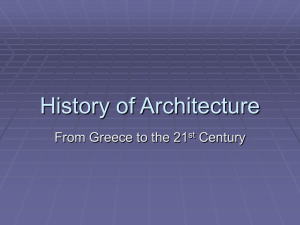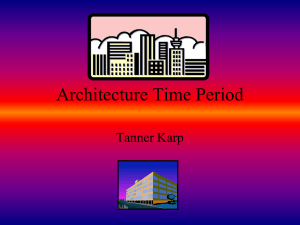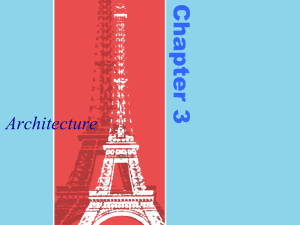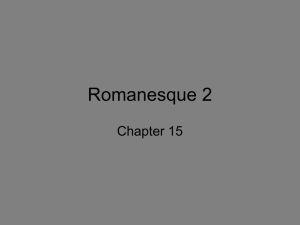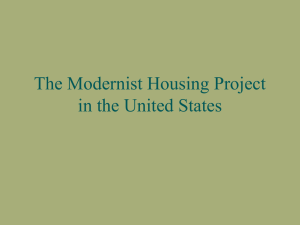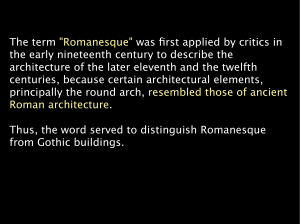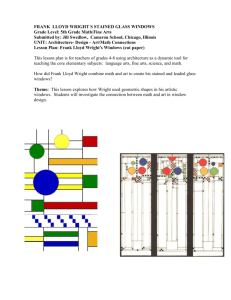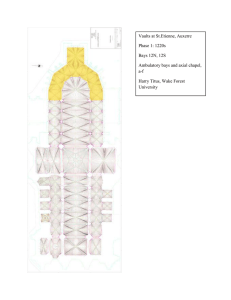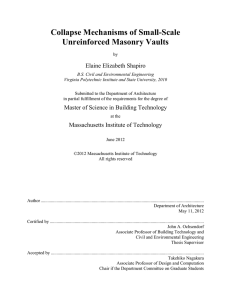History of Architecture
advertisement
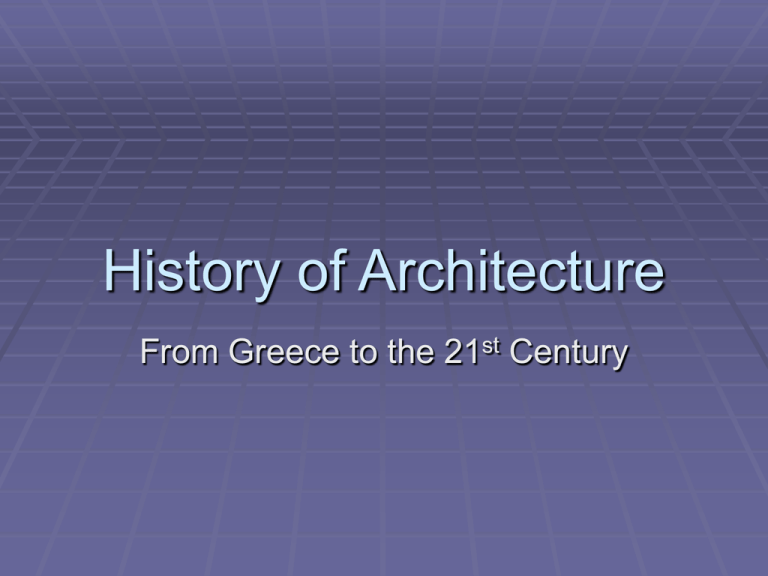
History of Architecture From Greece to the 21st Century American architect Ludwig Rohe rightly said “Architecture is the will of an epoch translated into space.” "The final goal of all artistic activity is architecture.“ -Walter Gropius Architecture is life . . . . . . or at least it is life itself taking form and therefore it is the truest record of life as it was lived in the world yesterday, as it is lived today or ever will be lived . . . -Frank Lloyd Wright, An Organic Architecture, 1970 Whatever else architecture is, it is at least an effort to enclose the greatest amount of unobstructed space with the least amount of material . . . ~R. Buckminster Fuller Ancient Greece The Parthenon, 450 BCE Athena, Classical Greece Doric order Post and lintel Colonnade, peristyle Optical refinements Athenian democracy Greek Orders Roman Architecture Rounded Arches replaced the post and Lintel system. Spacious interiors basilicas Use of concrete Use of Barrel vaults Examples of Important Roman Architecture Key Terms Rounded Arch Barrel Vault Pilasters Coffers Concrete Arcade Concrete Early Christian and Byzantine Art Earliest art forms found in the catacombs, underground passageways. Christian Basilicas modeled on Roman Empire admin centers-basilicas-to accommodate the large numbers of Christians. Technical advances from Roman architecture made making larger structures possible. Christian churches=sacred space for large congregations Plain Exterior but Ornate Interior The Basilica was designed with a large central aisle called a nave. At the end, there was a semi-circular area called the apse. Cruciform floor plan Basilica of Constantine Old St. Peter’s Sant’ Apollinare in Classe. Ravenna, Italy AD 533-49 Mosaics http://www.sacreddestinations.com/italy/ravenna-santapollinare-classe-photos/index.htm Byzantine Architecture Constantinople = capital 330 – 1453 CE Cross in square capped with domes Pendentives, piers Lavish interior, plain exterior Combine church + state Heavenly atmosphere, mysterious HAGIA SOPHIA, INSTANBUL, TURKEY Anthemias and Isidorus, 535 CE Hagia Sophia’s dome rests on four hug piers, massive vertical pillars, that support arches made of cut stone. Use of pendentives, transition pieces from wall to dome SAN VITALE, RAVENNA, ITALY 545 CE Central plan Concentric Octagons Off-axis narthex Interior golden mosaics Tesserae Justinian and Theodora Basilica Plan vs Central Plan Islamic Architecture Mihrab Qibla wall faces Mecca Taj Mahal, Agra, India, c. 1650 Mughal India Empire Romanesque Architecture 11th-12th Century Europe Combining features of contemporary Western Roman and Byzantine buildings Compartmentalized, cruciform Massive, sturdy piers, thick walls Round arch, barrel vault Stone sculpture Massive, segmented structure, fortress-like Accommodate pilgrims, ambulatory Regional differences, e.g. Durham Cathedral, UK Groin Vaults A groin vault or groined vault = the intersection at right angles of two barrel vaults. The word groin refers to the edge between the intersecting vaults. Sometimes the arches of groin vaults are pointed instead of round. In comparison with a barrel vault, a groin vault provides good economies of material and labour. The thrust is concentrated along the groins so the vault need only be abutted at its four corners. In the Gothic era, groin-vaulted naves were supported by flying buttresses. Barrel vaulted nave Example of Romanesque Architecture St. Sernin Toulouse, France c. 1,000 CE Romanesque Portal Gothic Art 13th and 14th Century Gothic is a term used to identify a period that began around the middle of the 12th century and lasted to the end of the 15th century and in some places, the 16th century. Romanesque style paved the way to the Gothic style Gothic Art Unified interior Pointed arches rather than rounded arches Ribbed groin vaults piers, compound piers Verticality Stained glass New Jerusalem Chartres Cathedral c. 1200 Dedicated to Virgin Mary Notre Dame The (West) Royal Portal, Chartres Cathedral Flying Buttreess “Flying Buttress” is a support structure that reach the side aisles of the church that created a thrustcounterthrust system that supports the groin-vaulted ceiling. Stained Glass Many stories of bible, Jesus, the Virgin Mary, etc. Colored Illuminations Size- huge areas in cathedrals were dedicated to these windows. Color-artisans added minerals to the glass while it was molten to color the glass Design-small pieces of stained glass were joined with lead-strips and reinforced with iron bars. Lux Nova Renaissance, Florence 15th Century Italy Brunelleschi Revitalized Classical ideals Clarity, harmony, geometry Ideal proportions Foundling Hospital Brunelleschi Florence Cathedral Dome = double shell Alberti Palazzo Ruccellai 1450 3 horizontal floors Vertical pilasters Strong cornice Baroque Relies on movement Large, meant to impress Facades undulate, interplay of forms Oval plans Interiors = richly designed, elaborate & Incorporated all the arts Landscaping becomes important in Eng/France Reason & Romance in England Chiswick House, 1725 Royal Pavilion, 1820 Cast Iron Age Joseph Paxton Crystal Palace, 1850 1st large freestanding iron frame building Glass curtain walls Enormous interior space Industrial Revolution Prefabrication Eiffel Tower Paris 1889 Wrought iron design Arts and Crafts Movement Arts and Crafts = late 19th-century movement to revive handicrafts Sought a spiritual connection with the surrounding environment, both natural and manmade Functional objects with high aesthetic value William Morris Green Dining Room Charles Rennie Mackintosh Ladies’ Luncheon Room Art Nouveau Outgrowth of Arts and Crafts Movement Relies on vegetal and floral designs Complex designs, undulating Curvilinear Wrought ironwork Buildings designed as whole works Antonio Gaudí Casa Mila Barcelona, Spain 1907 Art Nouveau detail on the Wainwright Building by Louis Sullivan Soaring To New Heights Late 19th century - Early 20th century Beginnings of the skyscraper Louis Sullivan, Form Follows Function “Modern” technology, smaller footprint Steel skeleton Orderly, light-filled, elevators, heating, ventilation Exterior expresses interior Sullivan, Guaranty Building Buffalo, NY, 1895 Organic Architecture Organic Architecture is a term Frank Lloyd Wright used to describe his approach to architectural design. The philosophy grew from the ideas of Frank Lloyd Wright's mentor, Louis Sullivan, who believed that "form follows function." Wright argued that "form and function are one." Organic Architecture Organic architecture strives to integrate space into a unified whole. Frank Lloyd Wright was not concerned with architectural style, because he believed that every building should grow naturally from its environment. Frank Lloyd Wright Taliesan West Robie House PRAIRIE STYLE Frank Lloyd Wright Kauffman House – FALLING WATER 1939, Bear Run, Pennsylvania Bauhaus School of architecture and design, Germany, 1919 - 1933 All art forms should be designed as a unit Technology embraced Economy in the use of space, materials, time, and money Avoid Romantic embellishments Walter Gropius, The Bauhaus, 1925 Dessau, Germany International Style Le Corbusier’s dictum= Building= “Machine for modern living” Clean lines Skeletal system Great planes of glass wrap walls of Ferroconcrete construction Austere glass box, devoid of ornamentation Le Corbusier, VILLA SAVOYE, 1929 Poissy-sur-Seine, France Philip Johnson, Glass House New Canaan, Connecticut, 1949 Art Deco Popular in 1920’s and 1930’s Reaction to simplified forms of International Style Streamlined art that focused on industry Motifs from industry, machine aesthetic Motifs from industry and machines, e.g. cars, Cruise ship portholes and railings Celebrates “modern” living William Van Alen, THE CHRYSLER BUILDING New York, 1930 Extending the International Style Less Is More Rietveld Schroder House, Utrecht, The Neterlands, 1924 Mies van der Rohe Seagram Building New York 1955 Later Le Corbusier Notre Dame du Haut, Ronchamp, France, 1955 Later Frank Lloyd Wright Guggenheim Museum, New York, NY, 1959 Postmodernism 1960’s – 1970’s Out with “sleek” -- anything goes Use of past elements self-conciously\ Embraces history, symbolism, ornamentation, playful Transform, distort, exaggerate features Connect with public Diversity is king -- multiplicity “MODERNISM” focused on function & technology Postmodern Michael Graves, Disney World Swan Hotel Orlando, Florida, 1989 Michael Graves Portland Public Services Building Portland, Oregon 1983 Deconstructionist 1970s Seeks to disorient Disrupts conventional categories of architecture Disorder, dissonance, asymmetry Haphazard volumes, masses, planes Challenges assumptions/views about architecture Frank Gehry, Guggenheim Museum Bilbao, Spain, 1997
